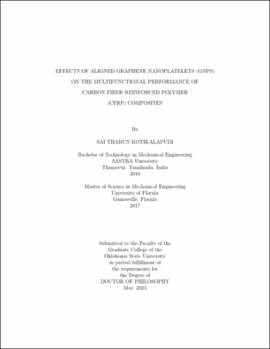| dc.contributor.advisor | Singh, Raman P. | |
| dc.contributor.author | Kotikalapudi, Sai Tharun | |
| dc.date.accessioned | 2023-08-30T19:45:12Z | |
| dc.date.available | 2023-08-30T19:45:12Z | |
| dc.date.issued | 2023-05 | |
| dc.identifier.uri | https://hdl.handle.net/11244/339020 | |
| dc.description.abstract | This study investigates the multi-functional behavior of carbon fiber reinforced composites (CFRP) with respect to energy storage and electrical conduction applications. CFRP laminates were subjected to long-term exposure of low-density electric field by passing direct current (DC) through cross-ply laminates. The laminate resistance and the temperature changes due to Joule heating effects were monitored. A permanent change in physical material characteristics is caused by the following phenomenon, thermal decomposition of epoxy, dielectric breakdown at the carbon/fiber interface and thermal mismatch during heat/cool cycles. A 13–15% reduction in compressive strength, 6–7% reduction in Young’s modulus in thickness direction, 3–4% decrease in glass transition temperature, and 41–45% increase in tan δ was observed. Through thickness conductivity and CT scans of degraded samples showed the evidence of delamination. The inherent difference between through-thickness and in-plane properties of CFRP is the leading cause of these detrimental effects. Highly conductive aligned graphene nanoplatelets (GNPs) has the potential to bridge the inadequacies. | |
| dc.description.abstract | The unidirectional alignment process of transversely isotropic GNPs in epoxy was characterized by AC conductivity measurements. Epoxy nanocomposites reinforced by aligned GNPs are developed through out of plane electric field alignment during the curing process. A semi-empirical approach is developed to quantify the alignment process considering various parameters such as viscosity of the epoxy-blend, dimensions of the GNP and electric field strength. The quality of alignment is found to be a function of electric field intensity and concentration of GNPs. We notice an increment in dielectric constant and loss, and Young’s modulus for aligned samples. We also observe and characterize the brownian movement and the growth of dielectric properties overtime. However, alignment of GNPs resulted in a heterogenous composite. The planar alignment of GNPs in epoxy is also characterized by AC conductivity measurements. Epoxy nanocomposites reinforced by GNPs oriented with their long-axes parallel to the direction of electric field are developed during the curing process. A rotating electric field about z-axis with varying speeds for different sizes and concentrations is used to systematically align GNPs. The planar aligned GNPs is characterized by XRD analysis, SEM images and dielectric spectroscopy. | |
| dc.format | application/pdf | |
| dc.language | en_US | |
| dc.rights | Copyright is held by the author who has granted the Oklahoma State University Library the non-exclusive right to share this material in its institutional repository. Contact Digital Library Services at lib-dls@okstate.edu or 405-744-9161 for the permission policy on the use, reproduction or distribution of this material. | |
| dc.title | Effects of aligned graphene nanoplatelets (GNPs) on the multifunctional performance of carbon fiber reinforced polymer (CFRP) composites | |
| dc.contributor.committeeMember | Sallam, Khaled | |
| dc.contributor.committeeMember | Vaidyanathan, Ranji | |
| dc.contributor.committeeMember | Harimkar, Sandip | |
| osu.filename | Kotikalapudi_okstate_0664D_18068.pdf | |
| osu.accesstype | Open Access | |
| dc.type.genre | Dissertation | |
| dc.type.material | Text | |
| dc.subject.keywords | alignment | |
| dc.subject.keywords | carbon fiber | |
| dc.subject.keywords | characterization | |
| dc.subject.keywords | graphene | |
| dc.subject.keywords | nanocomposites | |
| dc.subject.keywords | polymer | |
| thesis.degree.discipline | Mechanical and Aerospace Engineering | |
| thesis.degree.grantor | Oklahoma State University | |
